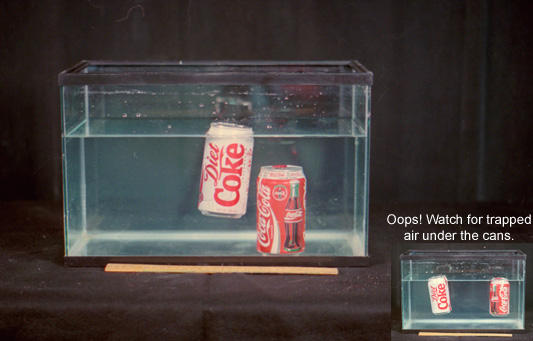What it shows
An unopened can of Diet Coke floats in a tank of water, whereas the same cannot be said for a can of regular Coca-Cola.

Setting it up
Use the smallest available tank. If unopened cans are not already in the Prep Room, they can be procured from one of the vending machines near the elevators in the basement of the Science Center. Put everything on a small A/V cart near the audience so everyone can see directly. Start with both cans out of the water so that the audience has a chance to predict the outcome. Have towels ready.
It is fairly easy to fool the audience into thinking that both float on their own. The bottoms of each can are concave, so if one holds the Coke can perfectly upright when lowering it into the tank, enough air can be trapped under the can to make it buoyant. To debunk the prank, give the can a slight nudge and the air bubble will surface.
Comments
Although a volume of 355 mL is printed on the side of each can, we have found by simply pouring the contents into a graduated cylinder that they each contain about 352 mL of liquid. Since the mass and volume of the aluminum can and compressed gas are nearly the same for Coke and Diet Coke, the deciding factor becomes the specific gravity of the liquid contents. Our own rough experiment—weighing different volumes of liquid in a graduated cylinder—gives an average density of 0.911 g/mL for Diet Coke, and 1.026 g/mL for regular Coke. Alternatively, one could examine the "Nutrition Facts" written on the can of regular Coke and calculate the density of a solution consisting of 352 grams of water and 39 grams of dissolved sugar.